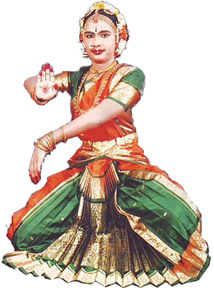Navarasas in Indian Classical dance forms
Subashini PATHMANATHAN
Navarasa is a unique feature in Indian classical dance forms. Mainly
in the South Indian Classical dance forms, Indian Classical dance forms
and South Indian folk dance forms such features could be seen.
Interpreting the meaning of the songs, the dancer uses facial
expressions and hand gestures. Explaining and expounding the meaning of
the song through hand gestures is known as Abinaya.
In Hindu mythology the term Nava plays important role. Nava means
nine in numbers. In Hinduism Nava grahams mean nine to planets, Nava
rathiri reveals nine nights, pertaining to three different goddesses,
Nava shakthi means nine shakthis. Nava thaniya means nine different
grains used for poojas and religious rituals in Hinduism. Nava Kol means
nine important planets.
 |
|
Facial expression is essential to
convey rasas |
Expressing the meaning of the song through the facial expression is
called as Bhava. The essence of Bhava is called Rasas. According to
Indian Classical dance forms there are altogether nine important Rasas
mentioned. Each Rasa is linked with emotions of human life, or linked
with different moods of human life.
The dancers, dramatics, and dance drama artists use these emotional
sentiments to interpret their meaning. Emotional touch or the sentiments
(rasas) could be seen not only in dance, drama, dance drama, teledrama,
and cinema, but also could be felt in music.
Moods are expressed through the bavas. The bavas and rasas are
inseparable. That's why it is always referred to Bhava rasas. According
to Natya Shasthra there are altogether nine rasas.
Sringara Rasa originates from the love or romance. This love emotion
involves, two types one is Samyoga, and other is viyoga. Samyoga means
the union of two lovers. Viyoga means the emotion which arises out of
separation.
Karuna means benevolence; it arises due to the kindness, or sympathy,
or sorrow and disgust with pain. This is divided into three. One is
Dharamopagatal arises out of punishment; Ardhapacheya arises due to the
loss of wealth, Soka due to the grief, and mental distress. Veera arises
out of bravery. There are three kinds one is, by giving gifts (dhana
veera), another by charity (daya veera), and the last is (uddha veera).
Bhayanaka arises out of fear. There are altogether three types of
Bayanaka. Bayanaka which comes out of deceiving, is called Vyajan, and
fear arises out of wrong is called Aparadha, and another is Trasita
Bhayanaka which arises out of terror.
Beebacha emotion arises out of hatred, disgust, and dislike in life.
Raudra comes to human life due to anger, the Raudra arises out of words
which is called Vak, anger reveals out of make up is (Nepadhya), and
anger shows through limbs is anga rudra.
Another rasa is Hasya Rasa. Hasya Rasa means laugh. According to the
way of expression the laugh is divided into six categories. Those are
Smita (slight smile), Hasita (jesting way of laugh), Vihasta (Laughing),
Upahasta (ridiculous way of laughing), Apahasta (silly way of laughing),
and Athihasita (excessive laugh).
Adbutha Rasa, means wonder, or surprise, it can be divided into two,
one is celestial (divya), other is joyful (ananda).
In the rasa sequence order Santha is the last rasa, which brings
peace and consoles the mind. It joins the Rasa order later. After
undergoing all the struggles, and stresses, at last the mind rest in
peace.
|



